 W
WThe King of Jerusalem was the supreme ruler of the Kingdom of Jerusalem, the Crusader state founded by Christian princes in 1099 when the First Crusade took control of the city.
 W
WCharles I, called the Warrior, was the Duke of Savoy from 1482 to 1490 and titular king of Cyprus, Jerusalem, and Armenia from 1485 to 1490.
 W
WCharles II, also known as Charles the Lame, was King of Naples, Count of Provence and Forcalquier (1285–1309), Prince of Achaea (1285–1289), and Count of Anjou and Maine (1285–1290); he also styled himself King of Albania and claimed the Kingdom of Jerusalem from 1285. He was the son of Charles I of Anjou—one of the most powerful European monarchs in the second half of the 13th century—and Beatrice of Provence. His father granted Charles the Principality of Salerno in the Kingdom of Sicily in 1272 and made him regent in Provence and Forcalquier in 1279.
 W
WCharles the Short or Charles of Durazzo was King of Naples and the titular King of Jerusalem from 1382 to 1386 as Charles II, and King of Hungary from 1385 to 1386 as Charles II. In 1381, Charles created the chivalric Order of the Ship. In 1383, he succeeded to the Principality of Achaea on the death of James of Baux.
 W
WCharles III of Savoy, often called Charles the Good, was Duke of Savoy from 1504 to 1553, although most of his lands were ruled by the French between 1536 and his death.
 W
WCharles Albert was the King of Sardinia from 27 April 1831 until 23 March 1849. His name is bound up with the first Italian constitution, the Albertine Statute, and with the First Italian War of Independence (1848–1849).
 W
WCharles Emmanuel I, known as the Great, was the Duke of Savoy from 1580 to 1630. He was nicknamed Testa d'feu for his rashness and military aggression.
 W
WCharles Emmanuel II ; 20 June 1634 – 12 June 1675) was the Duke of Savoy from 1638 to 1675 and under regency of his mother Christine of France until 1648. He was also Marquis of Saluzzo, Count of Aosta, Geneva, Moriana and Nice, as well as claimant king of Cyprus, Jerusalem and Armenia. At his death in 1675 his second wife Marie Jeanne Baptiste of Savoy-Nemours acted as Regent for their nine-year-old son.
 W
WCharles Emmanuel III was the Duke of Savoy and King of Sardinia from 1730 until his death.
 W
WCharles Emmanuel IV was King of Sardinia from 1796 to 1802. He abdicated in favour of his brother Victor Emmanuel I.
 W
WCharles Felix was the Duke of Savoy, Piedmont, Aosta and King of Sardinia from 1821 to 1831.
 W
WCharles II or Charles John Amadeus, was the Duke of Savoy from 1490 to 1496 but his mother Blanche of Montferrat (1472–1519) was the actual ruler as a regent. In 1485 his father Charles I had received the hereditary rights to the Kingdoms of Cyprus, Jerusalem, and Armenia which were inherited by young Charles.
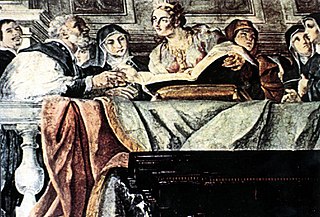 W
WCharlotte was the queen of Cyprus from 1458 until 1464. She was the eldest and only surviving daughter of King John II of Cyprus and Helena Palaiologina. At the age of 14, she succeeded to the Cypriot throne upon the death of her father. Her illegitimate half-brother, James, challenged her right to the crown. With the support of the Egyptians, he forced her to flee the island in 1463, and he was later crowned king. She made a military attempt to regain her throne, but was unsuccessful, and died childless in Rome.
 W
WEmmanuel Philibert, known as Testa di ferro, Piedmontese: Testa 'd fer, "Ironhead", because of his military career, was Duke of Savoy from 1553 to 1580. He is remembered for the recovery of the Savoyard state following the Battle of St. Quentin (1557), and for moving its capital to Turin.
 W
WFrancis Hyacinth was the Duke of Savoy from 1637 to 1638 under regency of his mother Christine Marie.
 W
WOtto von Habsburg, was the last crown prince of Austria-Hungary from 1916 until the dissolution of the empire in April 1919. He became the pretender to the former thrones, head of the House of Habsburg-Lorraine, and sovereign of the Order of the Golden Fleece in 1922, upon the death of his father. He resigned as Sovereign of the Golden Fleece in 2000 and as head of the Imperial House in 2007.
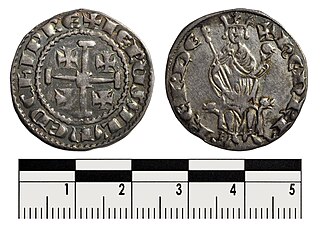 W
WHenry II was the last crowned King of Jerusalem and also ruled as King of Cyprus. He was a Lusignan dynast.
 W
WHugh IV was King of Cyprus from 31 March 1324 to his abdication, on 24 November 1358 and, nominally, King of Jerusalem, as Hugh II, until his death. The son of Guy, Constable of Cyprus, and Eschiva of Ibelin, Hugh succeeded his father as Constable of Cyprus in 1318, and later succeeded to the throne of Cyprus on the death of his uncle Henry II, since Henry II had no son. He was a member of the House of Poitiers-Lusignan.
 W
WJames II was the penultimate King of Cyprus, reigning from 1463 until his death.
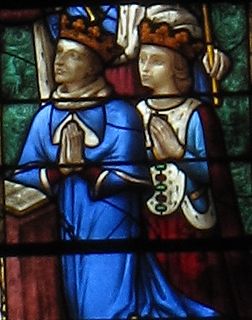 W
WJanus of Cyprus was a King of Cyprus and titular King of Armenian Cilicia and Jerusalem from 1398 to 1432.
 W
WJoanna I, also known as Johanna I, was Queen of Naples, and Countess of Provence and Forcalquier from 1343 to 1382; she was also Princess of Achaea from 1373 to 1381.
 W
WJoanna II was Queen of Naples from 1414 to her death, upon which the Capetian House of Anjou became extinct. As a mere formality, she used the title of Queen of Jerusalem, Sicily, and Hungary.
 W
WJohn II or III of Cyprus was the King of Cyprus and Armenia and also titular King of Jerusalem from 1432 to 1458. He was previously a titular Prince of Antioch.
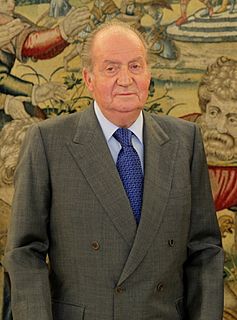 W
WJuan Carlos I is a member of the Spanish royal family who reigned as King of Spain from 22 November 1975 until his abdication on 19 June 2014. In Spain, since his abdication, Juan Carlos has usually been referred to as the Rey Emérito.
 W
WLouis I, Duke of Anjou was the second son of John II of France and Bonne of Bohemia. Born at the Château de Vincennes, Louis was the first of the Angevin branch of the French royal house. His father appointed him Count of Anjou and Count of Maine in 1356, and then raised him to the title Duke of Anjou in 1360 and Duke of Touraine in 1370.
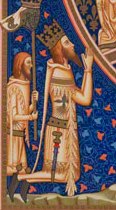 W
WLouis I, also known as Louis of Taranto, was a member of the Capetian House of Anjou who reigned as King of Naples, Count of Provence and Forcalquier, and Prince of Taranto.
 W
WRobert of Anjou, known as Robert the Wise, was King of Naples, titular King of Jerusalem and Count of Provence and Forcalquier from 1309 to 1343, the central figure of Italian politics of his time. He was the third son of King Charles II of Naples and Mary of Hungary, and during his father's lifetime he was styled Duke of Calabria (1296–1309).
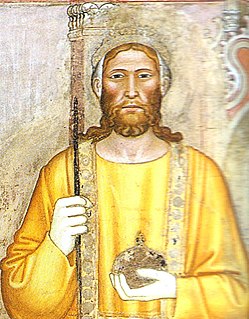 W
WPeter I of Cyprus or Pierre I de Lusignan was King of Cyprus and titular King of Jerusalem from his father's abdication on 24 November 1358 until his death in 1369. He was the second son of Hugh IV of Cyprus, the first by his second wife Alice of Ibelin. He was also invested as titular Count of Tripoli when young, in 1346. As King of Cyprus where he had military successes, but he was unable to complete many plans, due to internal disputes that culminated in his assassination at the hands of three of his knights.
 W
WPhilibert II, nicknamed the Handsome or the Good, was the Duke of Savoy from 1497 until his death.
 W
WPhilip II, surnamed the Landless, was the Duke of Savoy for a brief reign from 1496 to 1497.
 W
WRené II was Count of Vaudémont from 1470, Duke of Lorraine from 1473, and Duke of Bar from 1483 to 1508. He claimed the crown of the Kingdom of Naples and the County of Provence as the Duke of Calabria 1480–1493 and as King of Naples and Jerusalem 1493–1508. He succeeded his uncle John of Vaudémont as Count of Harcourt in 1473, exchanging it for the county of Aumale in 1495. He succeeded as Count of Guise in 1504.
 W
WRené of Anjou was Duke of Anjou and Count of Provence from 1434 to 1480, who also reigned as King of Naples as René I from 1435 to 1442. Having spent his last years in Aix-en-Provence, he is known in France as the Good King René.
 W
WUmberto I was the King of Italy from 9 January 1878 until his assassination on 29 July 1900.
 W
WUmberto II, full name Umberto Nicola Tommaso Giovanni Maria di Savoia, was the last King of Italy. He reigned for 34 days, from 9 May 1946 to 12 June 1946, although he had been de facto head of state since 1944, and was nicknamed the May King.
 W
WVictor Amadeus II was Duke of Savoy from 1675 to 1730. He also held the titles of Prince of Piedmont, Duke of Montferrat, Marquis of Saluzzo and Count of Aosta, Moriana and Nice.
 W
WVictor Amadeus III was King of Sardinia from 1773 to his death. Although he was politically conservative, he carried out numerous administrative reforms until he declared war on Revolutionary France in 1792. He was the father of the last three mainline Kings of Sardinia.
 W
WVictor Amadeus I was the Duke of Savoy from 1630 to 1637. He was also known as the Lion of Susa.
 W
WVictor Emmanuel II was King of Sardinia from 1849 until 17 March 1861, when he assumed the title of King of Italy and became the first king of a united Italy since the 6th century, a title he held until his death in 1878. Borrowing from the old Latin title Pater Patriae of the Roman emperors, the Italians gave him the epithet of Father of the Fatherland.
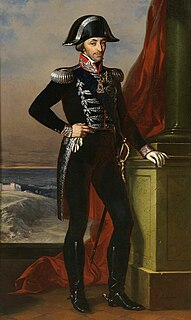 W
WVictor Emmanuel I was the Duke of Savoy and King of Sardinia (1802–1821).
 W
WVictor Emmanuel III reigned as King of Italy from 29 July 1900 until his abdication on 9 May 1946. In addition, he was Emperor of Ethiopia (1936–1941) and King of the Albanians (1939–1943). During his reign of nearly 46 years, which began after the assassination of his father Umberto I, the Kingdom of Italy became involved in two world wars. His reign also encompassed the birth, rise, and fall of Italian Fascism and its regime.
 W
WPrince Vittorio Emanuele of Savoy, Prince of Naples is the only son of Umberto II, the last King of Italy, and his wife Marie-José of Belgium. Vittorio Emanuele also uses the title Duke of Savoy and claims the headship of the House of Savoy. These claims were disputed by supporters of his third cousin, Prince Aimone, 6th Duke of Aosta.